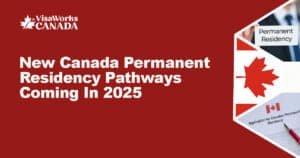News Release by Immigration, Refugees, and Citizenship Canada
Table of Contents
ToggleThe Honourable Marc Miller, Minister of Immigration, Refugees, and Citizenship, recently introduced the 2025-2027 Immigration Levels Plan, signaling a strategic shift in Canada’s immigration approach. The updated plan focuses on creating a balanced, sustainable model by regulating population growth, especially through moderated targets for international students, foreign workers, and permanent residents.
Highlights of the 2025-2027 Immigration Levels Plan
- Objective: To ensure population growth aligns with Canada’s infrastructure and economic goals.
- New Targets:
- Temporary residents: international students, foreign workers.
- Permanent residents with economic and social integration as a priority.
Minister Miller shared that the approach reflects Canada’s commitment to balancing growth and stability while addressing crucial labor market needs.
Why This Plan?
After the pandemic, Canada’s labor demand surged, calling for more skilled professionals across sectors. Immigration helped the nation recover faster and support key industries. However, Canada now faces housing, infrastructure, and social services pressures that affect both immigrants and Canadians. This updated immigration plan ensures that while the country attracts the brightest minds globally, it does so in a way that fosters both economic stability and population balance.
Through this revised plan, Canada aims to preserve the quality and integrity of immigration programs. Managed carefully, the strategy supports not just economic growth but a stronger social foundation for Canada’s future.
2025-2027 Population Forecasts
The Immigration Levels Plan anticipates a small population decline of 0.2% in both 2025 and 2026, followed by growth of 0.8% in 2027. This aligns with the projected reduction in new admissions for both permanent and temporary residents.
Reduced Permanent Resident Targets
In line with public feedback, Canada’s permanent resident targets have been lowered. The revised numbers reflect an intentional reduction:
- 2025: 395,000 permanent residents.
- 2026: 380,000 permanent residents.
- 2027: 365,000 permanent residents.
This change enables Canada to continue welcoming newcomers while managing pressures on urban centers and public resources.
Adjusted Temporary Resident Volumes by 2026
One of the key adjustments involves a target to reduce temporary residents to 5% of Canada’s population by the end of 2026. This goal addresses concerns about the growing student population, which impacts local communities, housing availability, and services.
Canada has taken the following steps to meet these new targets:
- Caps on international students.
- Revised eligibility requirements for temporary foreign workers.
These measures ensure that the number of incoming temporary residents aligns with Canada’s long-term economic and community goals.
Supporting Key Immigration Initiatives
The 2025-2027 plan emphasizes transitioning qualified temporary residents into permanent residents, particularly those with established skills, employment, and social integration in Canada.
Key Points:
- Transition from Temporary to Permanent Residency:
Canada aims to streamline pathways for those already in the country to achieve permanent status, focusing on individuals who are employed, skilled, and economically integrated. This approach minimizes additional demands on housing and public services. - Focus on Economic Growth in Key Sectors:
Canada’s plan ensures that by 2027, 61.7% of permanent resident admissions will be economic-class immigrants. This will address critical gaps in healthcare, trades, and other high-demand industries, making the most of skilled newcomers’ expertise. - Strengthening Francophone Communities:
In a move to diversify and support Canada’s Francophone populations, immigration targets for Francophones outside Quebec will increase to 10% by 2027. This initiative bolsters Francophone communities, fostering economic stability and cultural preservation.
Statistics and Insights
Canada’s population reached 41 million in April 2024, largely driven by immigration. Temporary residents, including students and foreign workers, accounted for nearly 60% of this growth. This surge has supported sectors across Canada but has also heightened demand for housing and essential services, particularly in urban centers.
By moderating immigration growth over the next few years, the plan is expected to support economic targets, such as steady GDP growth, improved housing affordability, and reduced unemployment. This balanced approach benefits both new immigrants and existing Canadians, ensuring a cohesive, prosperous society.
For those looking to establish a career, study, or settle in Canada, VisaWorks Canada Ltd. offers tailored guidance. Our team provides expert assistance with visa applications, residency pathways, and beyond. Reach out today to explore your options in Canada.
Explore Our Services
Quick Facts
- Canada’s population has expanded to 41 million, with immigration accounting for nearly 98% of recent growth.
- The plan seeks to stabilize GDP growth, improve housing availability, and address labor market gaps in priority sectors.
- By 2027, the strategy aims to reduce Canada’s housing supply gap by approximately 670,000 units.
Additional Immigration Measures
To ensure a sustainable immigration model, the government has introduced several initiatives to manage volumes effectively:
- Reformed International Student Program:
New caps and eligibility standards will help balance the number of students, preserving housing and resources for all residents. - Revised Foreign Worker Eligibility:
Updated conditions for temporary foreign workers ensure that Canada only brings in individuals with essential skills that align with national goals.
These changes aim to maintain a robust immigration framework that supports Canada’s economy, social infrastructure, and quality of life.
FAQs
What are Canada’s new immigration targets for 2025-2027?
Canada’s updated targets include 395,000 permanent residents in 2025, 380,000 in 2026, and 365,000 in 2027. These align with broader economic and social sustainability goals.
How will temporary resident numbers change?
Temporary resident volumes will decrease, aiming for a 5% share of Canada’s population by 2026. This reduction is due to new measures, including caps on student visas and stricter criteria for foreign worker eligibility.
What are the benefits of the adjusted immigration plan?
This plan promotes balanced economic growth, reduces pressures on housing, and addresses labor shortages in critical sectors like healthcare and trades.
How does this plan support Francophone communities?
The plan aims to increase Francophone immigration outside Quebec to 10% by 2027, enhancing the economic and cultural strength of these communities.
VisaWorks Canada Ltd. is here to assist with all your immigration needs, from visa applications to permanent residency pathways. Contact us to begin your Canadian journey today.








